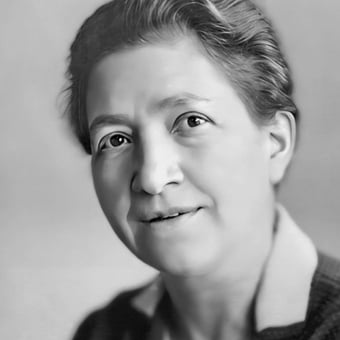
Maria Herz
The development of Maria Herz’s compositional work took place within a decade. Between 1922 and 1932, her chamber, orchestral, and piano music experienced wide public exposure in concert, conservatory, and radio venues. The daily and trade newspapers took notice, paid respect, and endeavored to classify and evaluate the situation with erratic judgements often laden with resentment. Unprejudiced are the voices of Martin Friedland, editor at the Kölner Tageblatt since 1926, Herbert Eimert, staff member of the Westdeutsche Funkstunde AG, and that of Theodor W. Adorno. In general, the leading music critics of the time acknowledged the independence and nobility of Maria Herz’s compositions. Their attention was particularly caught by the Four Short Orchestral Pieces op. 8, the Five Orchestral Songs on texts by Stefan George op. 7, and the Radio Music op. 9 for eight instruments. The latter obviously shows evidence of the composer’s keen perception of the media-technological developments of the time and the new requirements associated with them, insofar as the nascent radio stations of the 1920s saw in this op. 9 a particularly attractive offer. Until the violently effected end of Maria Herz’s public activity and her subsequent falling silent as a composer, this transparently composed ensemble music, which also called for the then popular saxophone, remained present in the radio stations. The Frankfurt broadcast of op. 9 by members of the Rundfunk-Symphonie-Orchester under Hans Rosbaud on 7 November 1930 was preceded by a lecture by Adorno, which undoubtedly marked the high point of the contemporary Herz reception. In terms of scope, content, and analytical depth, it has to the present day not, nor not yet again, been matched.
To begin with, this is due, after the recent rediscovery, to a cataloguing of the oeuvre that is largely still in its early stages. A reliable catalog raisonné is as yet a desideratum as is a reliable printed edition of Maria Herz’s works, which after all extended to op. 15. Printed during her lifetime were only a few piano songs: in 1910, during her first sojourn in England, “La fileuse” and two collections, both called Two Songs, issued by Stainer & Bell, the London publishing house with which her English composition teacher Arthur Edward Grimshaw was also associated. In 1927, the Chaconne from Bach’s Partita in D minor BWV 1004, arranged for string quartet, appeared in the catalog of Simrock Berlin. It was to become one of the most frequently performed works and, thanks to the efforts of Cologne’s Prisca Quartet and the Manzer Quartet, made Maria Herz’s name known also beyond Europe.
Thus, what remains for the time being as an approach to Maria Herz’s understanding of music, manner of composition, and compositional thinking are those observations that Adorno set forth in his radio lecture. They are outlined here. The starting point is an extended characterization of the sphere, which opens the horizon beyond the Cologne scene. “Maria Herz and Trude Rittmann studied with Philipp Jarnach, Busoni’s friend, who today actually represents the stipulations of Busoni’s aesthetic in the practice. The material with which the Little Radio Music and the [Little] Chamber Suite [for coloratura soprano and chamber orchestra] reckon is the same. Namely, a kind of extended tonality” (Gesammelte Schriften, vol. 18, p. 558). What happens in op. 9, what happens in the Radio Music, can be related, according to Adorno, to the “mindset” of the Busoni school. “It is known, that in music, Busoni was one of the first to express criticicism of romanticism and to postulate stipulations of an art of playing with regard to it, which today, as the new objectivity, have long since been devalued into a phrase” (p. 559). Adorno does not want the term “playing” to be understood in the sense of youth-movement-like collective music-making, but rather in the sense of “masque: non-binding, unreal, and full of the awareness of one’s own infeasibility.” If Busoni, so Adorno, acted against romanticism, then it was with an attitude that was still romantic, which becomes all too clear in his choice of Nietzsche to aid his argumentation. “Something of this romantic spirit of the unromantic is also inherent in the compositions of Jarnach himself as well as of his two pupils, and that is precisely what makes up their special nature.” As proof, Adorno points to the “songlike middle movements of Herz’s compositions, especially the third, an intermezzo almost in the Brahmsian sense, belonging to the romantic sphere. But at the same time already distanced from it.” And summing up: “They are both Spielmusiken in that Busonian sense; not the playing of a musical-primordial community, but the playing of individuals who, with banter and mask, enter into a world of form whose power of form they are no longer subject to” (p. 560).
Can that which Adorno remarks in conclusion about Busoni – “in all production on the borderline of romanticism” – also be applied to the Jarnach pupil Maria Herz? If so, it would result in a Janus-faced simultaneity of the look to the future, away from romanticism, and equally back to romanticism. In the program sheet for the premiere of the Four Short Orchestral Pieces op. 8 by the Gürzenich Orchestra Cologne under Hermann Abendroth on 15 October 1929, Herbert Eimert found these words: “Contemporary attitude and subtle assurance in personal expression. As an essential trait of her works, a spiritually directed clarity of feeling averse to all outward splendor shows itself, from which arises the preference for the means of chamber music, the transparency of form, and a gesture of sound that at times inclines toward the ascetic.”
Georg Beck
